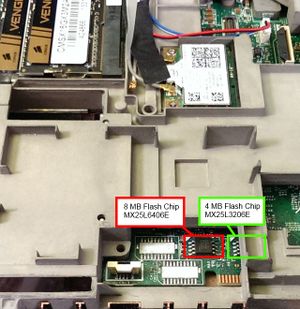Board:lenovo/t530: Difference between revisions
Eocallaghan (talk | contribs) m (→Known issues) |
Eocallaghan (talk | contribs) |
||
| Line 19: | Line 19: | ||
+-1f.2 8086:1e03 | +-1f.2 8086:1e03 | ||
\-1f.3 8086:1e22 | \-1f.3 8086:1e22 | ||
== Status == | == Status == | ||
Revision as of 17:43, 13 September 2014
Specification
The machine has:
- Chipset: Intel QM77
- GPU's: Intel Integrated HD Graphics
: Discrete NVIDIA NVS 5400M (1 GB VRAM) with Optimus Technology
and pci configuration of:
-[0000:00]-+-00.0 8086:0154
+-02.0 8086:0166
+-16.0 8086:1e3a
+-19.0 8086:1502
+-1a.0 8086:1e2d
+-1b.0 8086:1e20
+-1c.0-[02]----00.0 1180:e823
+-1c.1-[03]----00.0 8086:4238
+-1c.2-[04-0b]--
+-1d.0 8086:1e26
+-1f.0 8086:1e55
+-1f.2 8086:1e03
\-1f.3 8086:1e22
Status
Thanks for your interest in Lenovo T530 port. Issues:
- EHCI output failure after sysagent
- no S3
- no MRC cache
- MRC needs watchdog
- yellow USB port isn't powered in power-off state.
(Tested on X230 *not tested* on the T530):
- RAM module combinations of 8G+8G
- USB (both 2.0 and 3.0 ports)
- Video (both internal and VGA)
- Expresscard slot (including hotplugging)
- Sound (integrated speakers, integrated mic, external headphones, external mic)
- LAN
- mini-PCIe slots (both wlan and wwan)
- Linux (through GRUB-as-payload)
- Windows (through GRUB-as-payload loading SeaBIOS image from disk; you have to use extracted VGA blob, dumped from memory isn't good enough)
- SD card slot
- Thermal management
- Fingerprint reader.
- Webcam
- Keyboard backlight
- Thinklight.
- bluetooth
- dock
- msata (fixed in commit c8f54a1109072706e2fa091dc9ab4ad3eb057b42)
Not tested:
- mini displayport (probably works)
Proprietary components status
- CPU Microcode (optional)
- VGA option rom
- MRC
- ME(Management Engine) => you do not have to touch it(just leave it where it is)
- EC(Embedded Controller) => you do not have to touch it(just leave it where it is)
GPIO layout
This information should not be considered reliable in any way, shape or form
- GPIO57 - OUT - controls..
General Purpose Events layout
- GPE? - EC SCI
- GPE? - EC SMI
Flashing

T530 has 2 flash chips of 8M and 4M. They're concatenated to one virtual flash chip of 12M which is itself subdivided in roughly in 4 parts:
- Descriptor (12K)
- ME firmware (5M-12K)
- System flash (7M)
ME firmware is not readable. Vendor firmware locks the flash and so you need to flash externally (unless until someone figures out a way around it).
Proceeds as follows:
- Turn off your laptop, remove battery and AC adapter.
- Remove the keyboard.
- Connect your external SPI flasher to the top SPI chip which is under palm resting space, on left side of the board. It's a 4M chip. IF you've chosen CBFS_SIZE 4M or smaller that's the only chip you need to reflash.
I recommend using SOIC clip. Depending on the flasher you use, you may have to use separate 3.3V source. Make sure not to feed more than 3.3V ot the chip. I used buspirate as flasher and 3.3V power lines from another computer.
- Read the flash. Twice. Compare the files to be sure. Save a copy of it on
external media.
flashrom -p <yourprogrammer> -r flash.bin flashrom -p <yourprogrammer> -r flash2.bin diff flash.bin flash2.bin
If they don't match, do not proceed. If the file is 8M, you're flashing wrong chip, connect to the right one.
- Write the flash. Since you have to write only top 4M, first split out those 4M:
dd of=top.rom bs=1M if=build/coreboot.rom skip=8
- Use flashrom to flash top.rom.
If you have trouble reading the chip successfully, the most common problems are
- insufficient power supply
- bad contacts
- too long wires
- bad pinout
The cable shipped with buspirate was too long, and needed to be trimmed.
See also In-System Programming